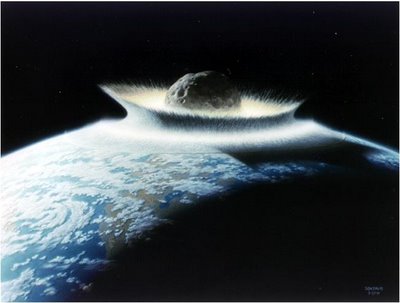
Una nota publicada hoy en Nature resume las últimas novedades de un a teoría que postula que el impacto de un cometa sobre la terra podría haber sembrado vida en otros planetas al dispersar bacteria terrestre al espacio.
Imagen: Don Davis
17.3.06
El posible origen de vida extraterrestre
Publicadas por
Andrés Hax
a la/s
3/17/2006
![]()
Suscribirse a:
Comentarios de la entrada (Atom)

1 comentario:
Published online: 17 March 2006; | doi:10.1038/news060313-18
Did Earth seed life elsewhere in the Solar System?
Impacts on our planet could have sprayed life into space.
Mark Peplow
Incoming, or outgoing? A giant collision into the Earth could fling life out to other planets.
© NASA
Earthly bacteria could have reached distant planets and moons after being flung into space by massive meteorite impacts, scientists suggest.
The proposal neatly reverses the panspermia theory, which suggests that life on Earth was seeded by microbes on comets or meteorites from elsewhere.
Both theories envision life spreading through the Solar System in much the same way that germs race around a crowded classroom, says Jeff Moore, a planetary scientist at NASA's Ames Research Center in Moffett Field, California. "Once one planet comes down with life, they all get it."
Spreading germs
Impacts on Mars and the Moon are known to throw rocks into space that end up on Earth as small meteorites. But spraying Earth rocks towards the edges of the Solar System is more difficult, because the material has to move away from the Sun's strong gravity.
Once one planet comes down with life, they all get it.
Jeff Moore
NASA's Ames Research Center, California.
To find out just how many rocks could reach the outer Solar System, a team of scientists used a computer model to track millions of fragments ejected by a simulated massive impact, such as the one that created the Chicxulub crater some 65 million years ago. Similar sized events are thought to have happened a few times in Earth's history.
The researchers looked in part at how many Earthly fragments would reach environments thought to be relatively well suited to life, such as Saturn's moon Titan and Jupiter's moon Europa. "I assumed the answer would be very, very few," says Brett Gladman, a planetary scientist at the University of British Columbia, Vancouver, Canada, who led the team.
But Gladman was surprised to find that within 5 million years, about 100 objects would hit Europa, while Titan gets roughly 30 hits. He presented the results at the Lunar and Planetary Science Conference in League City, Texas, on 16 March.
Tough journey
But could bacteria survive the sudden heat and acceleration of being thrown into space?
Other researchers at the conference suggest that they can. Wayne Nicholson, a microbiologist from the University of Florida in Gainesville, has tested the idea with a gun the size of a house at NASA's Ames Research Center.
He and his colleagues fired a marble-sized pellet at about 5 kilometres per second into a plate that contained bacterial spores in water, in order to simulate a meteorite impact. The debris that scattered upwards was caught in sheets of foam, and the team found that about one in 10,000 bacteria survived. "It's an experimental validation of a fairly well established calculation," says Moore.
Crash landing
Many astrobiologists believe that bacteria, once in space, could survive cosmic-radiation exposure during their trip. Unfortunately, a crash landing on Europa would almost certainly sterilize the few rocks that made it that far.
"But Titan is a different story," says Gladman. The moon's thick atmosphere would first shatter the meteorite before slowing the fragments down; the same process happens with meteorite impacts on Earth. "It's a nice safety net," Gladman says. The heat of landing could even melt the ice and open up a short-lived pool of liquid for the visitors, he adds.
At the conference, Gladman was asked whether, assuming a few bugs did make it safely on to Titan's surface, they could ever really thrive in the moon's chilly climes of about -170°C. "That's for you guys to work out," he told the audience. "I'm just the delivery boy."
http://www.nature.com/news/2006/060313/pf/060313-18_pf.html
Publicar un comentario